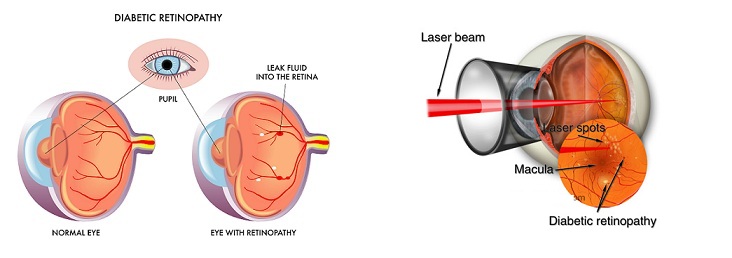Diabetic retinopathy is one of the leading causes of vision loss in both adult and child Americans
It occurs when there are structural changes to the blood vessels in the eyes. Mild nonproliferative Diabetic Retinopathy can be easily managed with medications and eye drops. In more severe forms, however, permanent damage to the blood vessel walls, called nonproliferative Diabetic Retinopathy, is possible. This is where vision loss becomes permanent, even after the initial treatments have failed.
These blood vessels in the eyes are responsible for carrying nutrients to the healthy blood cells. When blood flow is decreased, nutrients may become inaccessible to these cells, and as a result, they die off. As they die off, blood clot in the affected area, blocking vision and causing vision loss.
There are several treatments for vision loss caused by Diabetic Retinopathy, each with varying success rates and costs. The cost will depend on the severity of the vision loss, the type of treatment and the type of blood vessel affected.
Hypertension is often a contributing factor to this condition, so controlling high blood pressure through lifestyle changes can help control the problem. It is also important to monitor your blood pressure on a regular basis, especially if you are suffering from diabetes. If you find that your blood pressure is consistently higher than normal, it is best to see your doctor. He or she will be able to prescribe a blood pressure reading, which can be used to determine what types of blood vessel problems exist in your eyes.
Diabetic retinitis is also often a contributing factor to vision loss and is caused by damage to the blood vessels in the eye. In this case, surgery or radiation therapy may be required to repair the problem. Surgery is often recommended if you have had a recent eye injury. Surgery is also often recommended for older adults with diabetes who may not respond well to medication. In some cases, surgery may be necessary even if your eyes are fine and do not show signs of any visible symptoms.
Laser therapy is sometimes recommended for those suffering from retinal tears caused by diabetic eye problems. This procedure involves using lasers to temporarily change the color of the tears in the eye. These tears, as you may already know, are made up of fat, water and protein. and are found inside the tear ducts.

Laser surgery has proven very effective in reducing tears and the inflammation that accompanies them
The problem with this method of treating these tears is that the coloration of the tears changes over time. In general, though, the results are not permanent. This method has been used for over 50 years and works well, but is not guaranteed to work.
It is important to note that laser therapy cannot correct every tear and does not treat every tear. Some tears may need other treatments. Laser therapy is most effective for those who have tears in their eyes that are not related to Diabetic Retinopathy. A few tears may require surgery, and some tears can be treated with medications or eye drops.
For those who need laser therapy for Diabetic Retinopathy, surgery is usually required to repair the damage caused to the eye. Surgery removes excess tears, the source of the inflammation. It is important to note that this is a permanent solution for those who have tears in their eyes. Laser treatment will not correct existing tears and does not prevent tears from falling into the eye.
Laser therapy is not without risk, however. Because the laser is removing excess tears, the patient may experience a slight sensitivity to light, blurred vision, or distortion to vision, and even blurred vision after the treatment is complete. In addition, it is important to note that laser treatment will not cure your eye condition, but it can help improve it.
Patients who undergo laser treatment for their eyes may choose to wear eyewear, which is designed to minimize the effects of the treatment, although the outcome of laser treatment is not guaranteed. The most common way to wear eyewear is to cover the entire eye area at night.
Laser therapy for eyes is a safe and reliable alternative to traditional treatments for many people. If your doctor recommends this method of treating the tear and inflammation associated with diabetes, discuss your options with your eye care provider. It is important to remember that this option should not be used for every case of eye trouble, and your doctor may suggest that you use more traditional treatments first if the condition does not improve.
